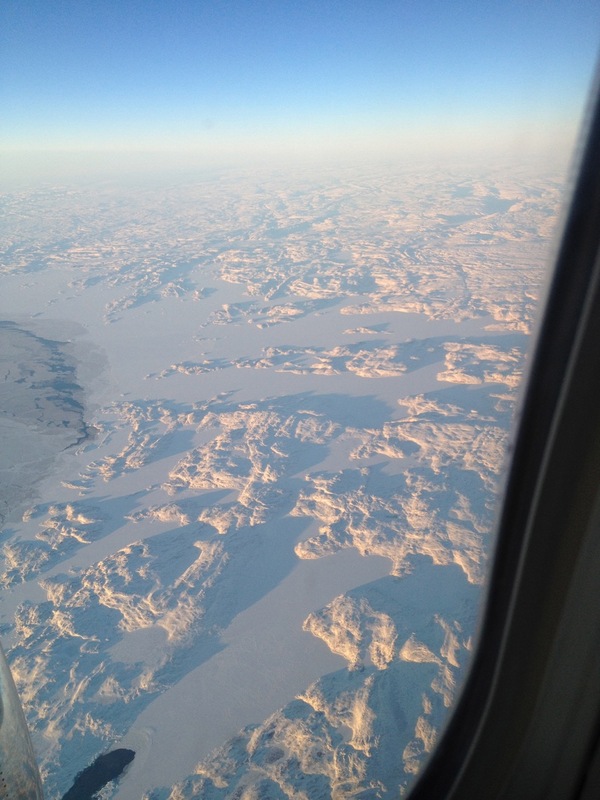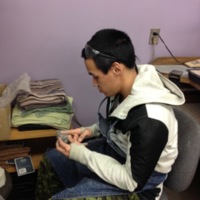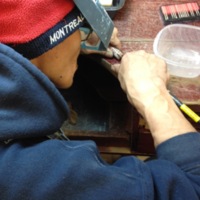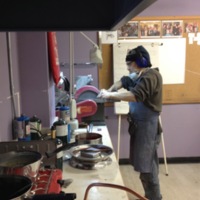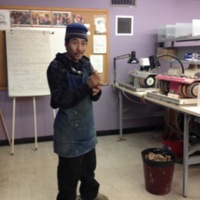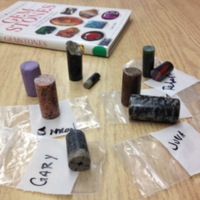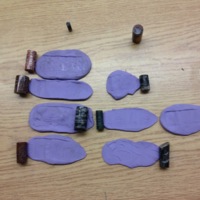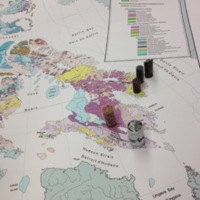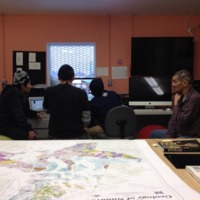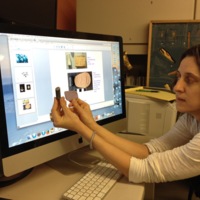ᖁᐊᖅ The Frozen Museum
Welcome to the Frozen Museum
Our museum is about our life in the Arctic, here in Nunavut.
We chose the name Frozen Museum ᖁᐊᖅ (quaq) because it seemed appropriate as we're up north. The Frozen Museum presents our exhibition of Inuit culture, showing how people live in the Arctic, and the way we use the land.
When we go out on the land, we don't use a map, and we don't bring a computer. We use the Inukshuk ᐃᓄᒃᓱᒃ and the North Star ᐅᓪᓗᕆᐊᕐᔪᐊᒃ. The Inukshuk is a human figure made out of a pile of large stones that is placed upon a hilltop as a marker for travellers, and these Inuksuit ᐃᓄᒃᓱᐃᑦ are special. They are always pointing somewhere, and they are our landmarks when we travel. In the sky, we use the North Star as our compass and our guide. When we go on hunts, sometimes for weeks, we use tools like the panak knife ᐸᓇᒃ which is called panak because it is made out of ivory or antler as opposed to metal. This is a large knife for cutting the snow blocks we use for making an igloo. We use the qamutiq ᖃᒧᑎᖅ, the dog sled, to carry our hunting equipment, as well as the animals we harvest - seal, walrus, caribou, and arctic char. And if you travel in summertime, you can use the tundra plant, qijutor ᕿᔪᒃᑕᑦ in many ways. We use it as fuel for fire, and we also make tea from this plant when it is dried (but be careful about which kind you use, as certain varieties can make you high or pass out). And its red flowers are used in medicine, called aupilatuq ᐊᐅᐱᓗᒃᑐ.
We show all of these things from our life and our culture in the jewellery that we are making. We use materials from the land, like soapstone for the qulliq ᖁᓪᓕᖅ which is the lamp or stove we use for cooking and heating, and we also use soapstone for the carvings we create. There are different varieties of this stone, in many colours; depending on the variety, it can be a hard or soft material to carve. Other organic materials we use in our jewellery are baleen, which are the teeth from the bowhead whale, we also use this whale's bone; and we use bone and nails from the seal, caribou antler, narwhal tusk, walrus tusk and teeth, polar bear teeth and claws. We use the skins from these animals too, for our clothing. Sealskin coats, boots, mitts - they are light and warm, and waterproof. Polar bear skin makes very good pants and mittens because they are very warm and soft. Caribou skin is used to make the parka, mittens, and the kamik ᑲᒥᒃ which is the boot; caribou is very warm and soft as well.
Our Exhibition
The Frozen Museum holds four exhibits that feature the work of four students - Gary, Simon, Juna and Peter - who are in the Jewellery and Metalwork Program here at Nunavut Arctic College (NAC), under the direction of Beata Hejnowicz. These past ten days, from 5-15 January 2016, NAC held a special jewellery history workshop that explored jewellery design, materials and technologies from across the centuries, led by Donna Bilak (Columbia University, History).
Based on our introductory lecture about ancient jewellery, our workshop project focussed on the creation of a cylinder seal, an ancient form of communication in which pictographs are reverse-carved onto a cylindrically shaped stone, whose message appears when the stone is rolled across a pliable substance like clay, or Plasticine in our case. Pictographs are the earliest form of writing; our jewellery history workshop looked at examples of cylinder seals from Mesopotamia, and we took this form of telling a story carved into stone into our own hands (so to speak). Thus, each of the Frozen Museum's exhibits tells a particular story about who we are, and how we live - what is important to us, and why.
Enjoy our Frozen Museum!
...and special thanks to Beata Hejnowicz, Senior Instructor of the Jewellery and Metalwork Program here at Nunavut Arctic College, for making this workshop possible; to Linda Ham, Chief Geologist at the Canada-Nunavut Geoscience Office (CNGO) here in Iqaluit for her guest lecture about the stones and minerals of this region; and to Serge Basso, Geotechnology Analyst at the CNGO for his technical expertise in handling the digital content of the Frozen Museum. We are grateful to the CNGO for its support as our host, here at frozenmuseum.cngo.ca.
Frozen Museum Curators:
Gary, Simon, Juna and Peter
Building The Frozen Museum
Our cylinder seal project unfolded across the course of the NAC workshop on jewellery history. It encompassed several stages of development - from its conceptual introduction through a lecture about ancient jewellery and techniques, to Plasticine prototypes of our seals, to the selection of local stones available in NAC's jewellery studio, to the emergence of each student's individual seal.
The following four exhibits - curated by Gary, Simon, Juna and Peter - feature each of their cylinder seals, and each one tells a story that is unique to its maker.
The final exhibit, "All About Seals," is a photo gallery that documents the entire process of our workshop and the creation of our cylinder seals. It also includes images taken during the special guest lecture by geologist Linda Ham, who opened up a whole new understanding of our seals for us, by showing us where in Nunavut each stone came from, and revealing to us the beauty and geological richness of the Canadian Arctic.
We all learned so much from each other in this collaborative workshop. Throughout, we were all teachers, as well as students. Each one of us had something unique, interesting, and important to share with the class. We have all come away from this experience enriched. We are pleased to share our work, our creative spirit, and all that we have learned, with you who have come to visit our Frozen Museum.
